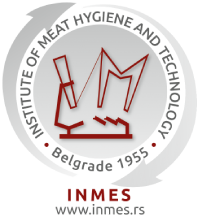Changes in the proximate and fatty acid composition in carp meat during the semi intensive farming
Abstract
The aim of this study was to examine and evaluate the proximate composition and fatty acid profi les of carp (Cyprinus carpio) during rearing in the semi-intensive farming conditions, supplementary fed extruded feed. Carp at the age of two years was submitted to trials, from spring to autumn, at the fish farm „Ečka“AD. Samples of carp were collected in April, June, September and October. The protein content in fi sh sampled in September was signifi cantly different from the protein content in fi sh sampled in April, June and October (p < 0.001), (17.48%, 17.27%, 18.28% and 17.26%, respectively). The quantities of total lipids slightly increased (2.25%, 2.37%, 3.02% and 4.72%, respectively) with the increase of the fi sh weight (598 g, 874 g, 1439 g and 1984 g, respectively), but signifi cant increases occurred between September and October (p < 0.001). The moisture content decreased (79.55%, 78.86%, 77.46% and 75.72%, respectively). Principal Component Analysis (PCA) and Linear Discrimination Analysis (LDA) indicated that there were significant changes in the fatty acid composition of carp during growth. Starting from April to October the quantities of fatty acids were as follows: SFA (saturated fatty acids) – 28.47%, 28.97%, 24.86% and 23.66%, respectively; MUFA (monounsaturated fatty acids) – 38.57%, 40.52%, 41.68% and 42.43%, respectively; PUFA (polyunsaturated fatty acids) – 32.53%, 30.49%, 31.53% and 32.55%, respectively.
The additional feeding of carp with the extruded feed influenced the increase in quantities of MUFA and n-6 PUFA (24.98%, 22.86%, 26.96% and 27.99%, respectively), and the decrease in quantities of the nutritionally important n-3 PUFA (5.13%, 6.59%, 4.57% and 4.57%, respectively). The highest n-3/n-6 ratio was obtained in June (0.30) and the lowest in October (0.16), indicating that the applied extruded feed was rich in n-6 and poor in n-3 PUFA. PCA and LDA have shown that significant changes in the fatty acid composition of carp during the breeding occured. Separation of the carp according to the sampling period was achieved by the LDA analysis, which is consistent with the type of ingested food.





